Why does it have to be so hard to find the best music equipment out there? Everyone has their own opinion, and it’s hard to weed out the good advice from unhelpful bias. If you’re looking to improve your drum practice and performance, you could easily make the wrong decision about equipment by listening to the first advice you get. That's why we're here to bring you the most thorough and objective guide to 2025’s best bass drum pedals. Keep reading below for the five best products that will give your sound the extra kick it needs.
We don’t mess around with mediocre products here. ******* We carry pedals that accommodate all budgets, but this guide is directed at the very best. ******** That’s because we know how seriously our customers take their musicianship. They’re not playing around; they want the products that are the most effective at a good price. The right bass drum pedal may pick you before you pick it. There are several jazz drummers that use pedals that are geared towards hard rock players, and vice versa. Ultimately what is best for you will be decided by you, we hope this guide can help. If you’re looking for the meat of what we’re offering here, allow us to tell you what’s in store with our best bass drum pedal recommendation, the Trick Pro 1V Bigfoot Single Bass Drum Pedal. Not only was it designed with aerospace materials, but it was also created closely with drummers so it really works to serve the person making the beats.
1. Trick Pro 1V Bigfoot Single Bass Drum Pedal - Best Pedal for Serious Drummers
PROS
- Built with tough materials
- Responsive
- Adjustable
CONS
- Can’t replace parts at the hardware store
- Not best for beginners
- No heel block
Our best choice for those who want to get serious about their musicianship is this Trick Bigfoot Single Bass Drum Pedal. It was built with precision-machined components made of aerospace materials such as titanium and stainless steel. Designed with engineering quality but built for drummers, it’ll take your noise to the next level.
Specifications
- Single
- Direct Drive system
- Part Number from the manufacturer: P1VBF1
Why We Love It
We love this pedal because it is not only beautiful to look at, but also because it has a number of cutting-edge features that make it stand out. You can expect a smooth, fast, and quiet internal compression spring mechanism that allows for an overall better experience. You can infinitely adjust the beater and pedal angles so it feels like it was truly made for you. On top of that, adjust the pedal tension while you play so you don’t miss a minute of the music. Don’t worry about it fitting on your beater, either. Their universal beater mount means it will fit anything on the market! Hand-assembled and individually inspected, you can rest assured that this piece is the highest grade available.
2. DW 9000 Double Pedal - For the Drummer Who Wants A Small Upgrade
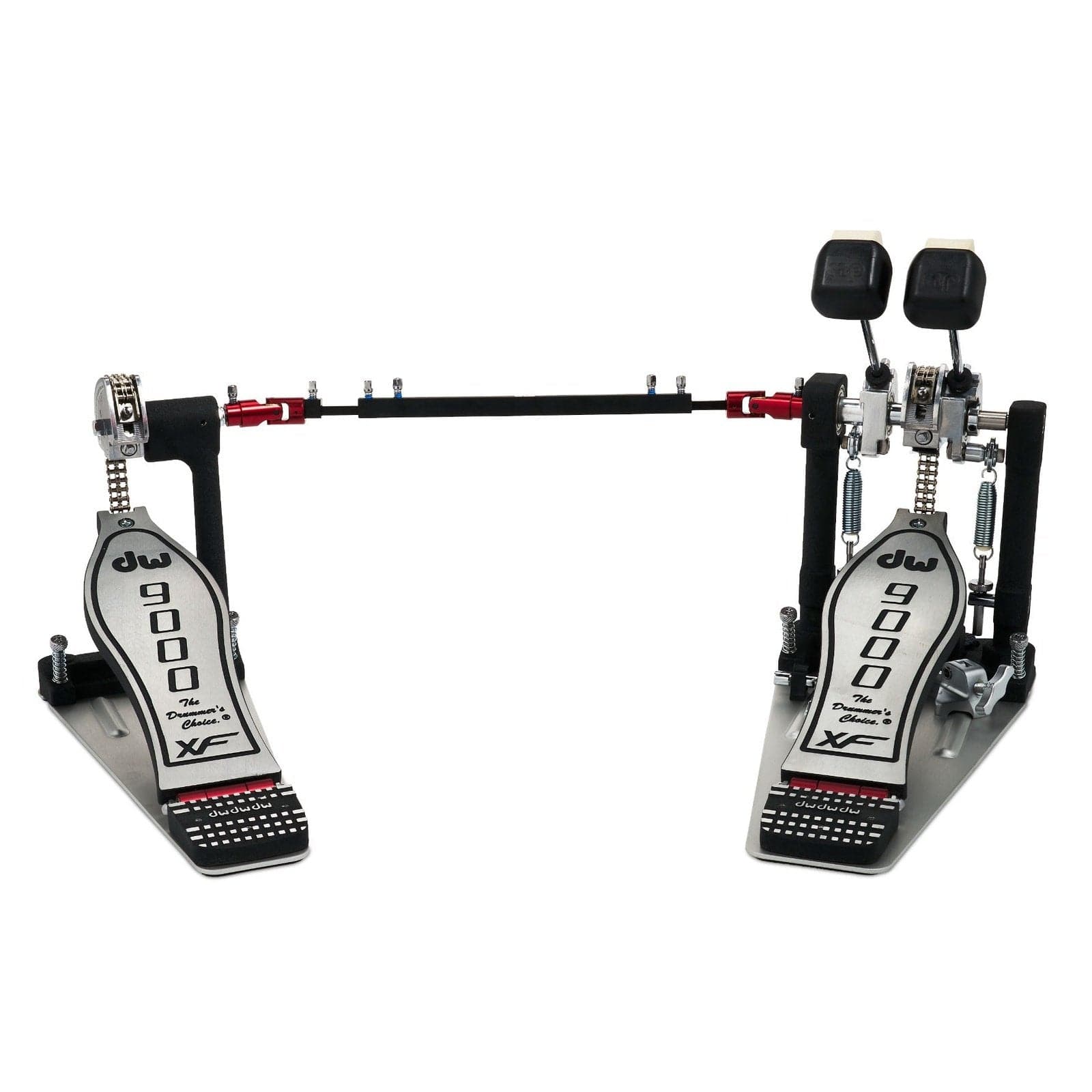
PROS
- Less resistance
- Great swing and feel
- Gorgeous carrying case for easy use
CONS
- May be issues with the back of the pedal getting stuck off the floor
- Weaker aluminum base plate may begin to twist
Love the original DW 9000 foot pedal, but looking for a small upgrade to more power? The DW 9000 Double Pedal Extended Footboard is just the thing you need. It packs the same great features and ability to adjust, just with a footboard that’s an inch longer! You’ll love its features like the Tri-pivot toe clamping system and the rubber grip base plate, which means no more slipping. You’ll find it easy to switch between regular drive and turbo drive to find the sweet spot for whatever kind of music you’re playing. Whatever your individual needs are, you can adjust the DW 9000 Extended to fit your ideal foot pedal settings.
Specifications
- Double
- Double chain drive system
- Manufacturer Part Number is DWCP9002XF
Why We Love It
We love this pedal because of its premium features that you normally can’t find in pedals around this price range. This includes things like the rotating swivel spring, free-floating rotor drive system, and the optional nylon strap that can be used to replace the chain-drive. If you’re looking for that one extra inch that could make all the difference, we think you can find it in the DW 9000 Extended Footboard.
3. Tama Dyna-Sync Single Pedal - For the Diverse Musician
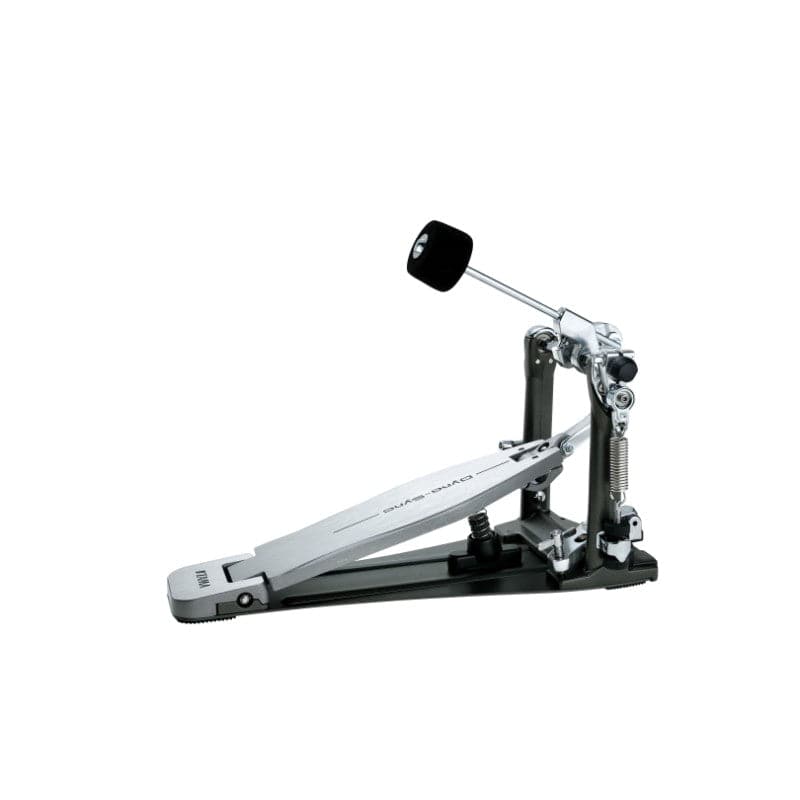
PROS
- Adjustable footboard to play all styles of music
- Completely eliminated side to side play with adjustable cam
- Developed closely with drummers
CONS
- Might take adjusting to louder strokes
- Spring tension might require some tweaking
TAMA spent a lot of time diving into the world of bass drum pedals before creating their own version here, the Tama Dyna-Sync Single and Double pedals. The three critical design components they focused on during creation included the linkage, the cam, and the footboard connection angle. Further, they used a diverse group of musicians to test out the products to make sure they worked for all high-level players. Using their feedback and careful engineering, they were able to work around many of the common issues associated with bass drum pedals and created what they believe to be the best pedals out there.
Specifications
- Single or Double, depends on which you choose
- Direct Drive
- Manufacturer Part Number is HPDS1
Why We Love It
These pedals offer a completely new combination of power, speed, and balance through a mechanical design system they call the Dynamic Synchronization System. We love these products because of their optimized transmission design, dual linkage and slidable cam for perfect adjustments. Any professional drummer who plays any demanding genre of music will benefit from this state-of-the-art pedal.
4. Yamaha Professional Double Pedal - For the Picky Drummer
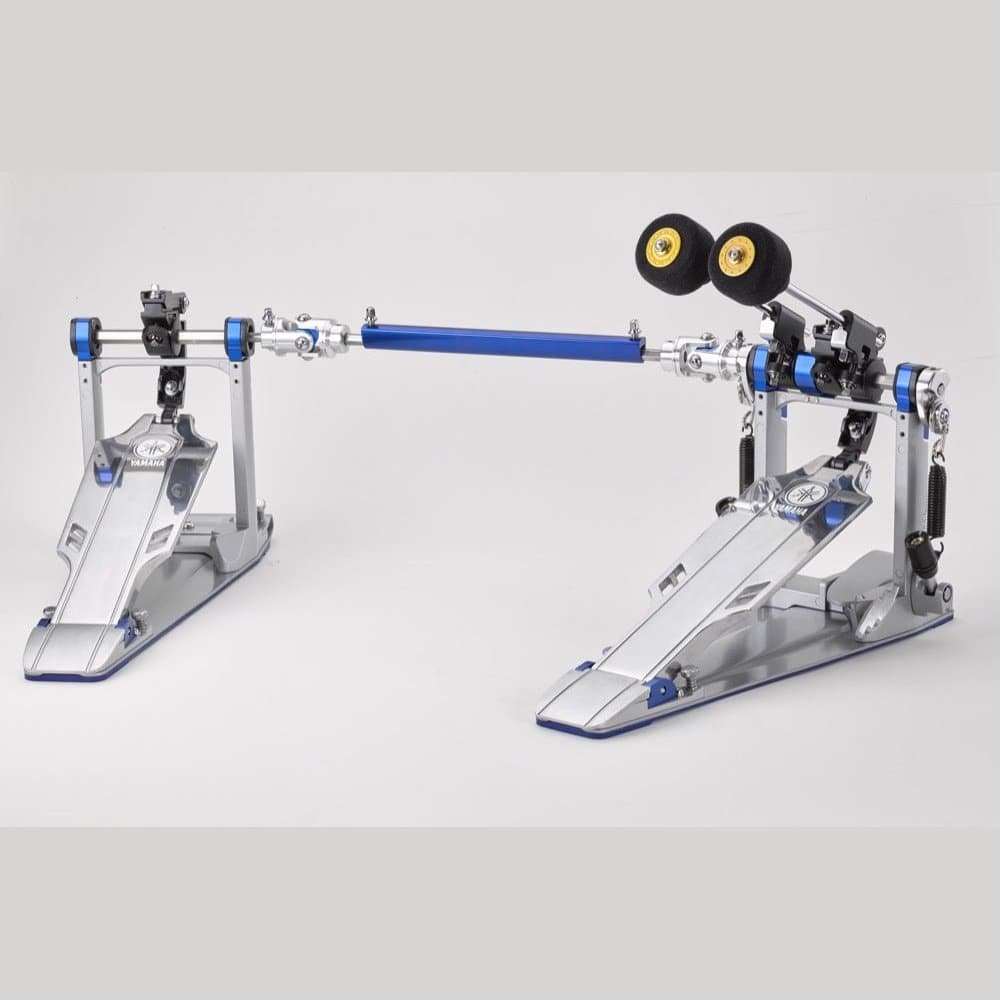
PROS
- Maximum stability
- Unified response between the two sides
- Change your pedal heights independently
CONS
- Springs might not get tight enough
- Can top-out against the top of the pedal if the footboard is too high
- May bottom-out against the floor if footboard is too low
These Yamaha pedals were designed and manufactured by the racing experts themselves, so you know these pedals pack some power. They spent a lot of time considering the foot and how it plays into the sound and power of bass drum pedals in order to create pedals that work with our foot’s natural movements. Even the pickiest drummers out there are sure to be satisfied by the Yamaha Professional pedals. This pedal allows for an incredibly smooth transfer of energy that’s nearly 1:1, thanks to dispersed ball bearings, front and rear spikes, and a frame-inside-a-frame design.
Specifications
- Double or Single, depending on which you choose
- Direct Drive
- Manufacturer’s Number is DFP-9D
Why We Love It
We especially love the ability these pedals have to self-lock spring tension rods. This makes it fast, easy and ergonomic to dial in each side from your own playing position. The adjustable weighted beater system is also great to fine-tune your power and speed. Find out more about this incredible category of bass drum pedals on the Drum Center of Portsmouth’s online store or call in to speak to one of our drumming experts directly.
5. Yamaha FP-9 Chain Drive Bass Pedal - Best Bass Pedal with a Classic Look
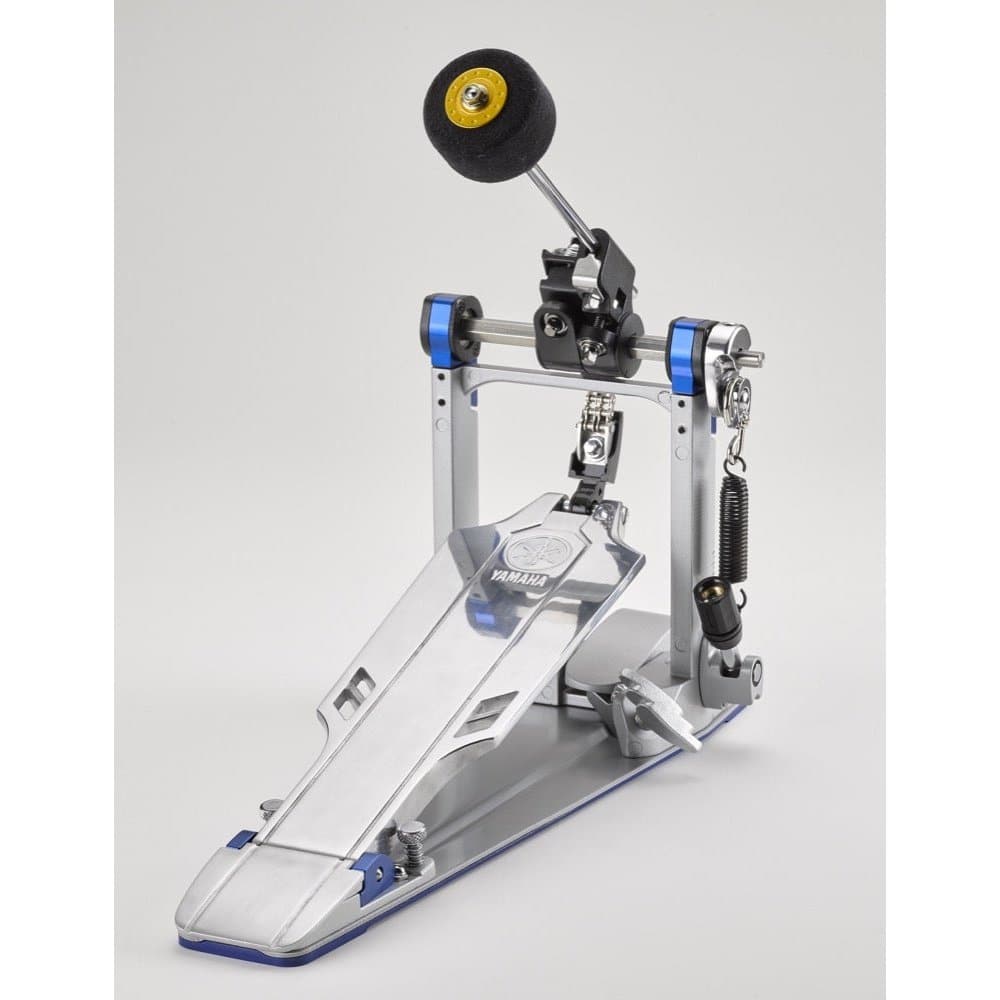
PROS
- Adjustable cams
- Auto-lock spring adjustment
- Anti-skid heel spikes
- Weight adjustable beater
CONS
- Extra thick heavy chain doesn’t flex as easily as it could
- Cam location in comparison to batter heads
This Yamaha model combines a classic look with a few striking twists. It is a light-weight design that produces a great sound against steel, black, and blue elements. Some new elements also include adjustable cams and linkages to create preferred pedal action. This allows users to adjust drum key bolt toggles as needed through the 3-position cam. With a double-chain model, drummers can move through smooth concentric action with nice tension or create an eccentric action with a heavy finish. It has an auto-lock spring adjustment with swivel spring mounting. Overall, this is a true Yamaha model with power and speed accompanied by gold and blue accents for a classic Yamaha look.
Specifications
- Auto-lock spring adjustment
- Cam and direct drive adjustment
- Secondary pedal anchor
- Heavy-duty casing with subframe
- Quick side-access hoop clamp
- Single chain
The FP-9 has slick, low playability that is easy to manipulate without limiting opportunities for sound. The design is stylish, smooth, and easy to adjust. Overall, we highly recommend this model that is available online and in stores. Check it out today!
6. Tama Speed Cobra 910 Single Pedal - Best Bass Pedals for Beginners
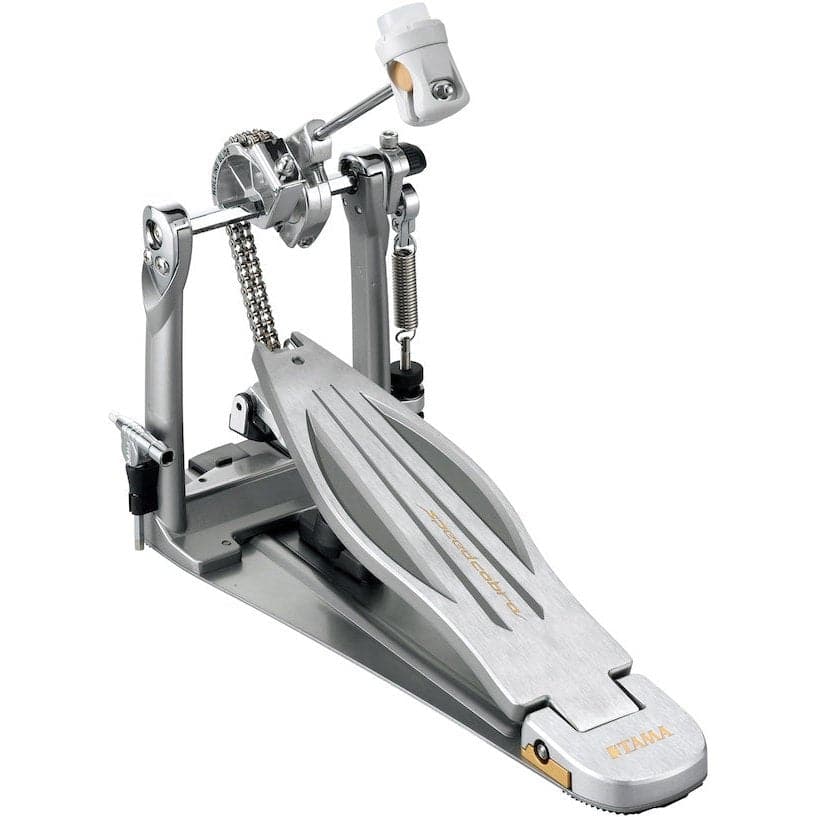
PROS
- Super Stabiliser Design
- Hard-shell carrying case
- Hinge guard block
- Affordable price
CONS
- Best suited for beginners
The Speed Cobra is a single kick drum pedal perfect for the avid player with the smooth, extra-long footboard. It gives extra leverage to minimise effort and allows for foot-slide techniques. The Super Stabiliser design created by the wide baseplate allows for complete stability. The Speed Cobra is also durable at the hinge point with a 3-piece Hinge Guard Block that also brings speed and control. The recessed setting feature is on top of the footboard and away from the cam, bringing natural motion not found on other designs. The Quick-Hook spring attachment prevents wobbling, so you will have maximum power transmission and control.
Specifications
- Long footboard
- Cobra coil return spring
- Swivel Spring Tight tension lock
- Para Clamp II prevents scratching
The number of features unique to the Tama Speed Cobra 910 makes it one of the best options for avid drummers. If you are looking for durability with natural ease, check this pedal out – available online and in-store!
7. DW 900 Single Pedal Extended Footboard - Best Bass Pedal with Extended Footboard

PROS
- Non-slip rubber grip base
- Secure Tri-Pivot Toe Clamp
- Footboard one inch longer than standard series
- Ease of cam adjustment
CONS
- Can take time to adjust to longboard length if not used to it
- Little variation in the beater
The 9000 series from DW Pedals combines input from drum techs and drummers for this pedal. It includes features like base assembly, plastic tube insulators, memory locks on tube joints, large reset handles, and more. It includes patented features like the free-floating rotor-drive system, infinitely adjustment cam, and rotating swivel spring. All of this combines for stroke optimisation, precision, and power. One of the most versatile features is the infinite adjustable cam that can be set from Accelerator to Turbo Drive and in between. The Free-Floating Rotor drive can turn independently of the rotor and transmit power from the board straight to the beater. Overall, the 9000 series gives smooth, gravity-defying action.
Specifications
- Double chain drive
- Single kick pedal
- EZ Infinite Adjustable Cam
- Free-floating rotor-drove system
The extended longboard design makes the DW 900 Single Pedal great for fast and rapid playing. This fluid pedal provides infinite adjustment options and can be found in-stores and online from the Drum Center of Portsmouth. Check it out today!
What to Consider When Buying Drum Petals?
Pedal Drives
Pedal drives are the mechanisms that connect the footboard of the pedal to the beater, which creates the sound. The three main types of pedal drives are:
- Chain
- Belt
- Direct
A chain-driven pedal is the most common, either as a single or double chain. The double chain is advantageous during long sessions because it reduces side-to-side movement. The belt-drive pedals chain with a solid belt. This can reduce friction sometimes and create a lighter feel. They can, however, suffer shorter life expectancies. Lastly, direct-drive pedals have a solid bridge between the beater and the foot pedal. This creates a perfect connection every time without any flexing or sideways movement. Heel-up players might find these less controllable.
Pedal Length
This feature is pretty self-explanatory since it addresses the length of the pedal. Pedal length isn’t as important as cam and drive, but it does affect comfort while playing. This should be decided based on the size of your foot.
Footboards
The two main kinds of footboards are the standard size and the extended size. You’ll find that most pedals feature a hinge by the heel, that allows for a flat base where the heel can rest. A longboard style of pedal is popular for drummers who really utilize rocking techniques to get rapid double strokes. In addition, drummers with larger feet can find more comfort in these extended pedals.
Cams
The cam is the portion that attaches the drive to the beater. The two types of cams include a linear and an offset version. While a linear cam keeps the same radius regardless of the beater’s speed, offset cams will accelerate the beater when it begins to get closer to the head. It begins to rotate, and the pedal will feel a bit lighter. But as the beater gets closer to the head, the feel will get heavier as the radius decreases. Some models will feature interchangeable cams for when you want to switch styles.
Preference
Arguably the most important thing to consider when shopping for bass drum pedals is your own personal preference. You can gather as many recommendations and look at as many reviews as you’d like, but you still won’t get the right product if you don’t know what you’re truly looking to get out of your chosen product.
FAQs
What to consider when buying bass drum pedals?
Many of the factors to consider are outlined here in the buyer’s guide. Some of it is personal preference, like pedal length and brand reputation. You should also consider price, skill level, and the type of music you want to play the most.
How much should I expect to spend?
This is entirely dependent upon your own budget, as the range for this kind of product greatly varies. You can spend under $100 if you need to be especially careful of your finances. On the other hand, if you’re looking to splurge and purchase one of the best products on the market, you should be prepared to spend upwards of $700 for a double pedal. It’s a good idea to shop around a bit first to get a better feel for the different price ranges before you narrow your search.
How do I know I'm ready to buy a bass drum pedal?
If you’re reading this article and you’ve made it to this point, that’s probably a pretty good first sign that you’re ready to buy a new bass drum pedal. In particular, you’re ready if you’re already a dedicated drummer that is interested in upgrading your performance and practice skills.
What is the difference between bass pedals and double bass pedals?
If you spend some time looking at the inventory on Drum Center of Portsmouth, you will see variations of the models here that are double bass pedals. Double simply means there are two pedals connected. If you have two bass drums on your kit, you might look into the double bass pedal options. If not, this is not a feature you would need. Deciding on a double bass kit is another personal preference for drummers.
Take Your Drumming to the Next Level
The bottom line is that there are some great pedals on the market, but you need to find the right one for you. Whether you’re a dedicated drummer, looking for more power, needing something to keep up with your diverse playing styles, or simply looking to upgrade a bit, your missing bass drum pedal is listed above! We’ve done the work for you to find the best of the best and lay it all out there so you can make an easy decision. Shop our pedals online or call us if you have any questions. We'd be happy to help you get set up with the bass pedal you need.




